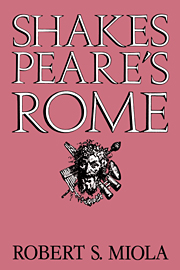Book contents
- Frontmatter
- Contents
- Acknowledgments
- Notes on sources
- I The roads to Rome
- II The Rape of Lucrece: Rome and Romans
- III Titus Andronicus: Rome and the family
- IV Julius Caesar: Rome divided
- V Antony and Cleopatra: Rome and the world
- VI Coriolanus: Rome and the self
- VII Cymbeline: Beyond Rome
- VIII Conclusion
- Index
- Frontmatter
- Contents
- Acknowledgments
- Notes on sources
- I The roads to Rome
- II The Rape of Lucrece: Rome and Romans
- III Titus Andronicus: Rome and the family
- IV Julius Caesar: Rome divided
- V Antony and Cleopatra: Rome and the world
- VI Coriolanus: Rome and the self
- VII Cymbeline: Beyond Rome
- VIII Conclusion
- Index
Summary
Like the historical city, Shakespeare's Rome rises and falls. In The Rape of Lucrece and Titus Andronicus Shakespeare depicts the city by relying heavily on stock myths and legends. Romans here, for the most part, are stereotypes, stiff figures of cardboard and paste, constructed from materials lying in the Elizabethan treasure chests of classical learning. Few have ever wept for Lucrece; fewer for Titus Andronicus. Both the narrative poem and the early play are exercise pieces: They give the artist a chance to compose Roman music, to try difficult themes, to practice his technique. Only style – artificial, overbearing, and rudimentarily conceived – holds them together.
Shakespeare's early experimentation results in two assured masterpieces, wherein imaginative vision fuses various traditions and soars to challenge and enthrall. Julius Caesar, Shakespeare's portrait of Rome divided, skillfully and movingly depicts the city that entangles itself with its strength. The playwright achieves this depiction by balancing audience sympathies and by creating a web of political and moral paradoxes. Julius Caesar is Shakespeare's Roman fugue – a contrapuntal composition in which the Caesar theme receives exposition and development by various voices. Each recurrence of the theme reveals new facets and evokes a slightly different response. Antony and Cleopatra, Shakespeare's study of Rome and the world, is his symphony. The play astonishes with its large scope, its sonorous majesty, its variety of mood and emotion. The contrasting Roman and Egyptian movements come to harmony and glorious resolution with the deaths of the lovers.
Descending from the heights, Shakespeare's imaginative vision of Rome concludes in Coriolanus and Cymbeline.
- Type
- Chapter
- Information
- Shakespeare's Rome , pp. 236 - 238Publisher: Cambridge University PressPrint publication year: 1983



